Are Unemployed Restaurant/Hospitality Workers Transitioning to Healthcare?

Is transitioning to healthcare a possible solution to the millions of unemployed restaurant/hospitality workers? Is that one way they can re-invest themselves and even possibly start new careers?
As the pandemic persists, this is a question many restaurant/hospitality workers have asked themselves; yet, some are still conflicted about leaving an industry they say constantly provides new experiences and engenders lasting relationships.
Before addressing this question, let’s step back to understand how the COVID-19 pandemic affected the global labor market and both the healthcare and restaurant/hospitality industries.
COVID-19 Global Labor Market Overview
According to We Forum, 114 million people lost their jobs over 2020 due to the COVID-19 pandemic.
In fact, the International Labor Organization (ILO) estimated that working hours lost in 2020 were equivalent to 255 million full-time jobs leading to $3.7 trillion in lost labor income.
Even though it’s been over a year since the pandemic begun, and millions of people have returned to work or are working remotely, there are still people who are unemployed. The ILO does not expect global working hours to return to pre-COVID levels this year.
Revenue and Workforce Impact on the Restaurant and Hospitality Industry Due to COVID-19
One of the sectors most affected since the beginning of the pandemic was the restaurant and hospitality industry. Let’s take a look at some critical stats. In the U.S.:
- 5 million jobs were lost since the February 2020 due to the customer shortage
- According to the Bureau of Labor Statistics, 38% of leisure and hospitality employees remain out of work compared to the national average of 10.2%
- $1.7 billion lost hotel employee earnings per week
- $2.8 billion lost hotel room revenue per week
- $46 billion+ lost room revenue since mid-February 2020
- $120 million+ lost by restaurant industry during the first 3 months of the COVID-19 outbreak
- 11% of all U.S. restaurants have been forced to close
- 61% of U.S. restaurants that shut down have marked closures as permanent
Within the industry, the cities most affected were Los Angeles, New York City, San Francisco, Chicago and Dallas.
The future of the restaurant and hospitality industry remains hopeful.
As COVID-19 restrictions begin to lift and more and more people get vaccinated, it is expected for some Americans to begin dining out and/or traveling.
However, there are still about 80% of restaurant customers who are still somewhat hesitant to dine-out and are continuing to use delivery, curbside, or pick-up services. Restaurant owners can also relate. Many restaurants are not expected to be fully operational during the first few months after reopening – in fact, approximately 90% of restaurant owners are still offering reduced services.
To help organizations recover from the impacts of COVID-19, relief/funding options such as the Paycheck Protection Program (PPP), Economic Injury Disaster Loan (EIDL), EIDL Advance, Targeted EIDL Advance, Express Bridge Loan, SBA Debt Relief, Shuttered Venue Operators Grant (SVOG) and the Restaurant Revitalization Fund have been made available throughout the pandemic. However, funds for these programs were limited and unemployment overall is still at 6.1% (or approximately 9.8 million) as of April 2021.
Demand for Healthcare Workers During COVID-19
No industry was pushed to their limits like the healthcare industry during the COVID-19 pandemic.
For years, the healthcare industry faced a physician shortage. However, when the pandemic began, physicians were faced with furloughs, pay cuts and unemployment. Overall demand for physicians went down due to sheltering at home orders, safety concerns, and hospitals and other surgical centers not scheduling elective procedures.
On the other hand, demand for nurses increased by 245% (or about 50,000 nurses) from September 2020 to December 2020, according to the new journal of studies data from hospitals using Epic Systems products – which also caused competition for new jobs.
According to the U.S. Bureau of Labor Statistics, pandemic related job losses in the healthcare industry were second when compared to those in the restaurant/hospitality industry. As the pandemic continues to subside, it is predicted that demand for physicians will begin to increase once again.
Is Transitioning to Healthcare a Possible Solution?
Unemployment benefits are a hot topic right now across the nation. About 11 states have decided to end unemployment benefits early and others are still determining what would be the best course of action for their state.
With millions of jobs available and jobs openings not being filled, many believe is it time for people to return to work.
Restaurant/hospitality workers that are seeking jobs and haven’t been successful in getting hired can consider healthcare as a short-term solution or even as a career change.
Healthcare continues to hold the most in-demand jobs and when compared to the restaurant/hospitality industry, they offer higher wages and, in most cases, better benefits.
So, is it really possible for restaurant/hospitality workers to consider transitioning to healthcare? The answer is yes.
A study conducted by The Federal Reserve Bank of Atlanta and The Center for Workforce and Economic Opportunity analyzes how restaurant/hospitality workers possess baseline skills that are transferable, making transitioning to healthcare and other, wide range of industries doable. To best analyze what transferable skills overlap in the service and healthcare occupations, they compared descriptor data for workplace activities rather than just basic skills all obtained from the U.S. Department of Labor and U.S. Bureau of Labor Statistics.
Here are some of their findings:
Potential Healthcare Pathways –
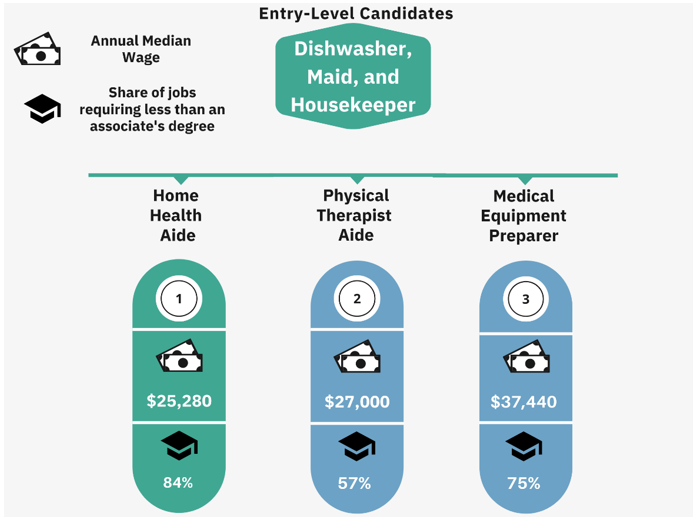
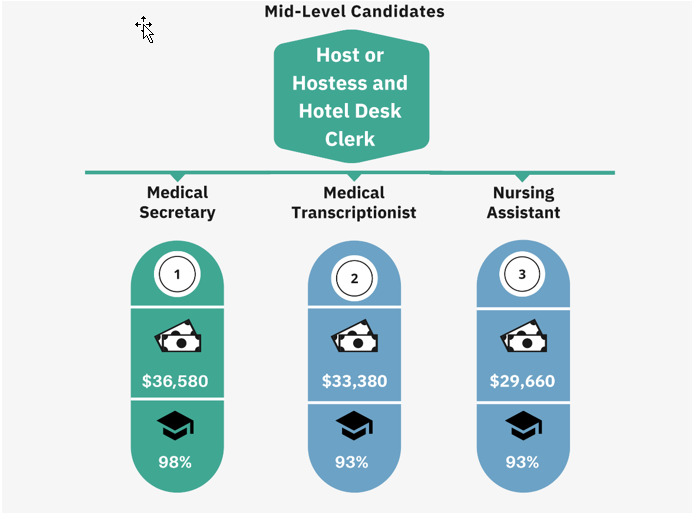
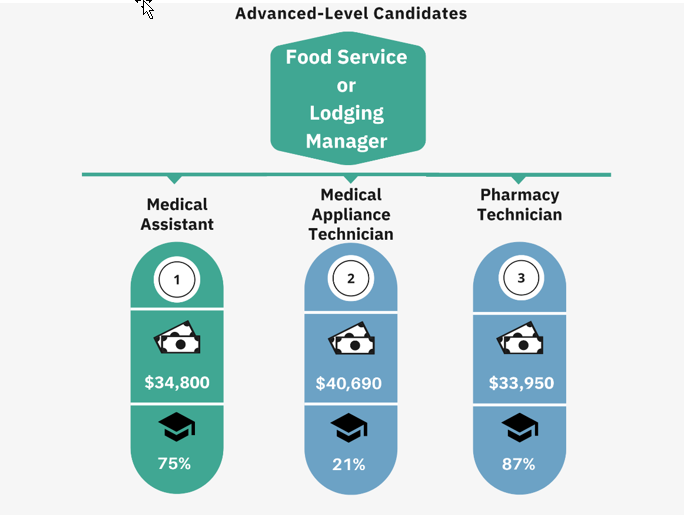
*Note: Some occupations such as certified nursing assistant and medical equipment technician were not listed due to certification and technical skill requirements. The occupations listed offer clear pathways for restaurant/hospitality workers to obtain immediate employment with potential for long-term advancement.
Work Activities & Technical Skills Overlap –
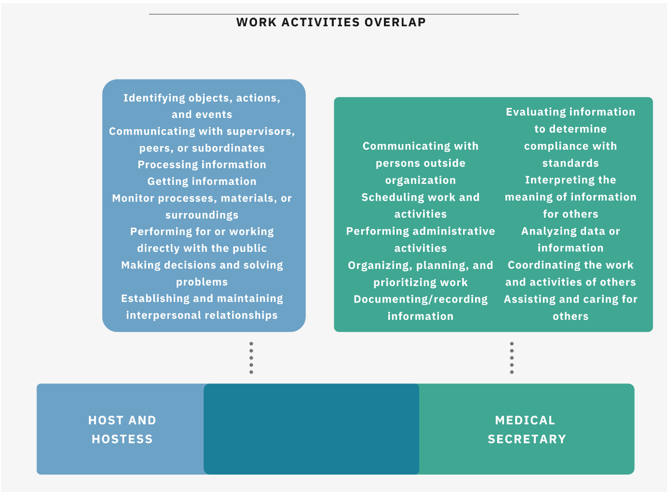

Service to Healthcare Pathways –
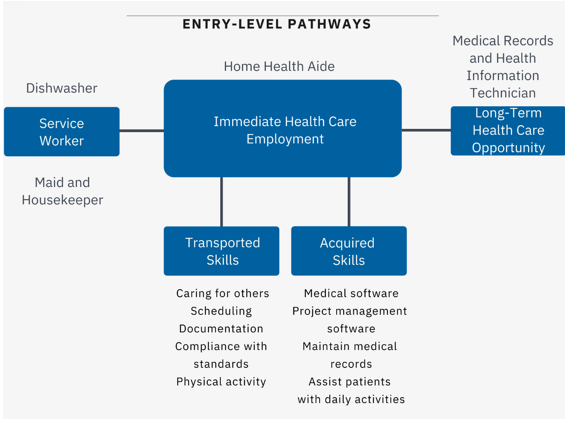
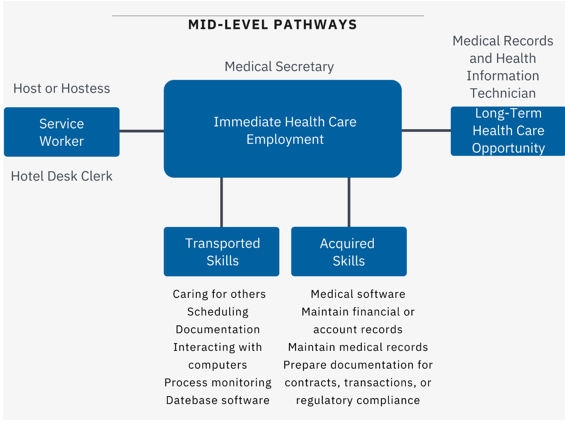
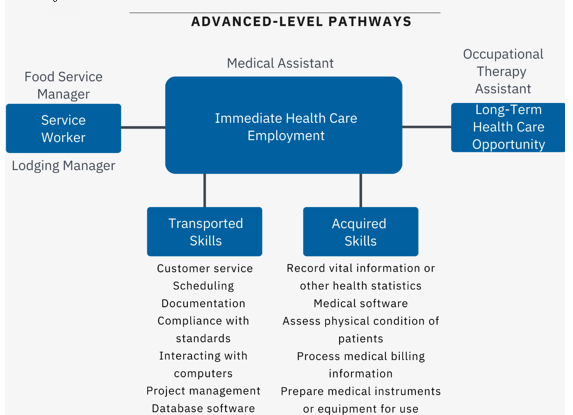
Key Takeaway
As you can see transitioning to healthcare is a possible solution for unemployed restaurant/hospitality workers.
But remember, it is our job as employers, workforce development agencies, professional associations etc. to strategically figure out how to reskill people for roles that are most in demand now due to the COVID-19 pandemic but also for other roles our economy needs to fill now and in the future.